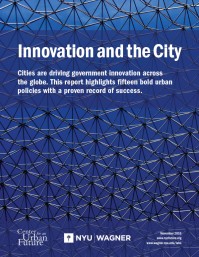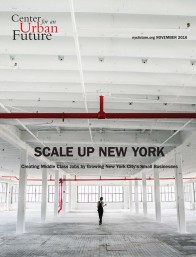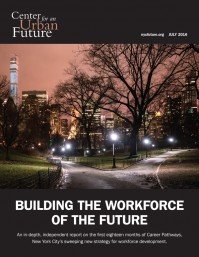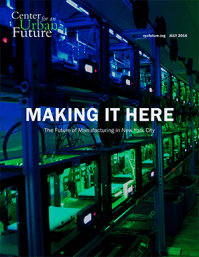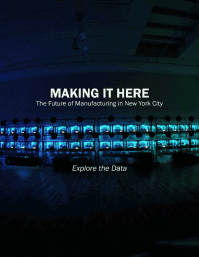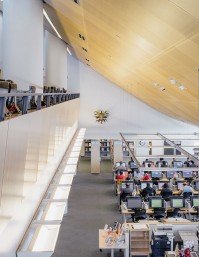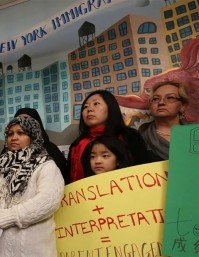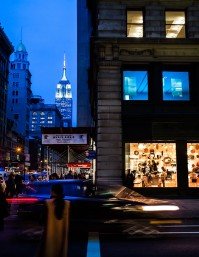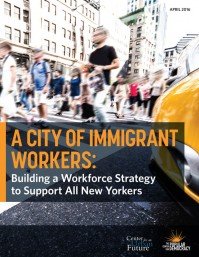Commentary/Op-Ed - November 2016
Op-Ed: To Grow Middle-Class Jobs, Shift Focus From Startup to Scale UpNew York City is humming with small-business activity. As small businesses expand, they create more mid-level positions and increase benefits for their workers, including paid sick leave, paid time off, and subsidized healthcare. When it comes to creating middle-income jobs in New York City, it’s time to think small.
Report - November 2016
Innovation and the CityAs urban growth has exploded over the past half century, cities have become the drivers of government innovation. From New York to Medellin to Copenhagen, mayors and city managers are finding novel ways to address some of the biggest challenges facing society, whether combating entrenched poverty, financing new infrastructure projects, or protecting the environment. Yet for all the innovative policies taking root in cities across the globe, there are few reliable mechanisms to share what is working. This report aims to fill the gap.
Report - November 2016
Scale Up New York: Creating Middle Class Jobs By Growing New York City’s Small BusinessesDespite the surge in the number of new small businesses and start-ups, too few of these companies manage to achieve sustained growth. A strategy to help small companies scale up is one of New York’s greatest unrealized opportunities for economic and employment growth—and one of the best chances to expand the number of middle-class jobs.
Data - October 2016
Where Immigrant New Yorkers Go to WorkImmigrants form an essential part of New York City's workforce. This data brief reveals where the city's immigrants go to work, including industries with a surprisingly high proportion of immigrant workers and others where immigrants are almost completely left out.
Data - September 2016
Jobs in Transit: Opportunity in the Transportation SectorThe transportation sector is growing in New York City, creating opportunities for accessible middle-wage jobs across the five boroughs. This data brief, the latest publication of our Middle Class Jobs Project, documents the industry's recent job gains, which have outpaced the city's overall economic growth over the past two years.
Commentary/Op-Ed - September 2016
Op-ed: Arts Funding Strategy Should Keep Pace with Brooklyn’s GrowthThe geography of art and culture in New York City has changed profoundly over the past two decades. Soaring rents have pushed artists to disperse, with studios, galleries, music venues, and performing art spaces opening throughout the five boroughs. City funding, however, has not shifted to reflect the changing landscape.
Commentary/Op-Ed - August 2016
Op-ed: Push hard to create more good NYC jobsMayor Bill de Blasio has made universal pre-K a reality and launched an ambitious plan to build and preserve 200,000 units of affordable housing. The next plank of the mayor’s inequality agenda should be a strategy to create middle-class jobs.
Report - July 2016
Building the Workforce of the FutureIn November 2014, New York City launched Career Pathways, the de Blasio administration’s signature overhaul of the workforce development system. This in-depth, independent report highlights the initial successes of Career Pathways, identifies areas where progress has stalled, and offers concrete recommendations to improve the new system's reach and effectiveness.
Report - July 2016
Making It Here: The Future of Manufacturing in New York CityA new wave of modern manufacturing companies are adding jobs across New York City, breathing new life into a sector that had been left for dead. Three of the city's manufacturing fields are particularly well positioned for growth in the years ahead: 3D printing, metal and wood fabrication, and food.
Data - July 2016
Data from Making It Here: The Future of Manufacturing in New York CityThe following data is part of CUF's 2016 Making It Here report. The report explores the new wave of modern manufacturing companies that are adding jobs across New York City, with a focus on three industries: 3D printing, wood and metal fabrication, and food.
Commentary/Op-Ed - July 2016
Rethinking New York’s Summer Jobs ProgramCity officials should be commended for expanding the city's flagship summer-jobs program, but a large gap remains between six weeks of summer employment and the beginnings of a career. Christian Gonzalez-Rivera, senior researcher at the Center for an Urban Future, argues for a new approach that invests in quality of experience over quantity of program participants and helps young people prepare for success in the workplace.
Commentary/Op-Ed - June 2016
Op-ed: Albany blows a chance to streamline city projectsIn this Crain's op-ed, CUF's Adam Forman calls out the New York state legislature's failure to pass a bill allowing cities to benefit from "design-build" contracting for public works, noting that state agencies already enjoy this advantage. In New York City, where infrastructure projects regularly blow through budgets and deadlines, design-build offers an opportunity to save time and reduce costs.
Commentary/Op-Ed - June 2016
Op-ed: City’s New Arts Funding Should Be Shared More FairlyThe city's recent budget agreement includes a $10 million boost for the Department of Cultural Affairs. In an op-ed for City Limits, CUF's Adam Forman argues that this welcome influx can be spent most effectively by prioritizing individual artists and small and mid-size organizations whose continued presence in the city is in jeopardy.
Commentary/Op-Ed - June 2016
Op-ed: A small boost in arts funding would go a long wayThe arts provides thousands of jobs, enriches communities, enlivens public spaces, and gives voice to immigrant and low-income residents. In this New York Daily News op-ed, CUF's Adam Forman urges the city to prioritize spending on cultural affairs.
Data - June 2016
Libraries Teach Tech: Building Skills for a Digital WorldThis new data brief finds that NYC’s public libraries are playing an increasingly important role in helping New Yorkers develop the technology skills needed in today’s economy. It shows that the city’s libraries provided tech training to more than 150,000 New Yorkers in 2015, an 81 percent increase from just three years earlier.
Data - May 2016
The Rise (and Fall) of Middle Wage Industries in NYCWhile the share of middle income jobs in New York City has declined over the past couple of decades, there is evidence that industries with middle income wages are staging a bit of a comeback.
Data - May 2016
Brooklyn Design BoomOur new data brief highlights the growing importance of the design sector to New York City’s economy, and details that a disproportionate share of the growth in the sector is now occurring in Brooklyn. It shows that employment at architecture and design companies in Brooklyn increased by 86 percent between 2010 and 2014, significantly outpacing the growth citywide (23 percent) and in Manhattan (19 percent).
Commentary/Op-Ed - April 2016
New York City Must Support Its Immigrant Population to Ensure a Successful WorkforceIn this City & State op-ed, CUF's Christian González-Rivera and CPD's Kate Hamaji argue that Career Pathways—New York City's new framework for its workforce development system—doesn't address the unique workforce challenges faced by the city's immigrant population. They lay out several steps that policymakers could take to better incorporate immigrants into the new workforce development strategy.
Testimony - April 2016
Opportunities for Women Entrepreneurs in New York CityIn this testimony before NYC Council’s Committee on Economic Development, CUF’s Jonathan Bowles presents several recommendations from our Breaking Through report to support women entrepreneurs and the growth of women-owned businesses in New York City.
Report - April 2016
A City of Immigrant Workers: Building a Workforce Strategy to Support All New YorkersImmigrants make up nearly half of New York City’s labor force but face significant challenges when it comes to accessing decent paying jobs and connecting to city-sponsored workforce development programs. With Career Pathways, Mayor de Blasio’s ambitious new approach to workforce development, the administration has an important opportunity to better incorporate the city’s immigrant workers into its workforce development strategy.


